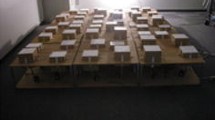Abstract
Engineers and researchers are paying more attention to reinforcement learning (RL) as a key technique for realizing adaptive and autonomous decentralized systems. In general, however, it is not easy to put RL into practical use. Our approach mainly deals with the problem of designing state and action spaces. Previously, an adaptive state space construction method which is called a “state space filter” and an adaptive action space construction method which is called “switching RL”, have been proposed after the other space has been fixed. Then, we have reconstituted these two construction methods as one method by treating the former method and the latter method as a combined method for mimicking an infant’s perceptual and motor developments and we have proposed a method which is based on introducing and referring to “entropy”. In this paper, a computational experiment was conducted using a so-called “robot navigation problem” with three-dimensional continuous state space and two-dimensional continuous action space which is more complicated than a so-called “path planning problem”. As a result, the validity of the proposed method has been confirmed.






Similar content being viewed by others
References
Sutton RS, Barto AG (1998) Reinforcement Learning. A Bradford Book. MIT Press, Cambridge
Kimura H, Kobayashi S (2000) An analysis of actor–critic algorithms using eligibility traces: reinforcement learning with imperfect value functions. JSAI J 15(2):267–275 (in Japanese)
Nagayoshi M, Murao H, Tamaki H (2006) A state space filter for reinforcement learning. Proc AROB 11th’06, pp 615–618 (GS1-3)
Nagayoshi M, Murao H, Tamaki H (2010) A reinforcement learning with switching controllers for continuous action space. Artif Life Robotics 15(1):97–100
Nagayoshi M, Murao H, Tamaki H (2011) Adaptive co-construction of state and action spaces in reinforcement learning. Artif Life Robotics 16(1):48–52
Author information
Authors and Affiliations
Corresponding author
About this article
Cite this article
Nagayoshi, M., Murao, H. & Tamaki, H. Developing reinforcement learning for adaptive co-construction of continuous high-dimensional state and action spaces. Artif Life Robotics 17, 204–210 (2012). https://doi.org/10.1007/s10015-012-0041-5
Received:
Accepted:
Published:
Issue Date:
DOI: https://doi.org/10.1007/s10015-012-0041-5




